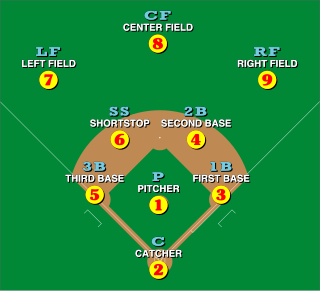 W
WBaseball is a bat-and-ball game played between two opposing teams who take turns batting and fielding. Within the game there are positions in which each participating player can play in.
 W
WIn baseball and softball, while there are nine named fielding positions, players, with the exception of the pitcher and catcher, may move around freely. The positioning for the other seven positions is very flexible, although they all have regular depths—distances from home plate, and sometimes lateral positioning. A shift means that a player is playing in a noticeably different location than the norm for his positioning. A fielder who is playing shallow or in is playing closer to home plate, while a player playing deep is playing farther from home plate than normal.
 W
WIn baseball, the term battery refers collectively to the pitcher and the catcher, who may also be called batterymen or batterymates of one another.
 W
WIn baseball, batting is the act of facing the opposing pitcher and trying to produce offense for one's team. A batter or hitter is a person whose turn it is to face the pitcher. The three main goals of batters are to become a baserunner, to drive runners home or to advance runners along the bases for others to drive home, but the techniques and strategies they use to do so vary. Hitting uses a motion that is virtually unique to baseball, one that is rarely used in other sports. Hitting is unique because it involves rotating in the horizontal plane of movement, unlike most sports movements which occur in the vertical plane.
 W
WIn baseball, the batting order or batting lineup is the sequence in which the members of the offense take their turns in batting against the pitcher. The batting order is the main component of a team's offensive strategy. In Major League Baseball, the batting order is set by the manager, who before the game begins must present the home plate umpire with two copies of his team's lineup card, a card on which a team's starting batting order is recorded. The home plate umpire keeps one copy of the lineup card of each team, and gives the second copy to the opposing manager. Once the home plate umpire gives the lineup cards to the opposing managers, the batting lineup is final and a manager can only make changes under the Official Baseball Rules governing substitutions. If a team bats out of order, it is a violation of baseball's rules and subject to penalty.
 W
WCatcher is a position for a baseball or softball player. When a batter takes their turn to hit, the catcher crouches behind home plate, in front of the (home) umpire, and receives the ball from the pitcher. In addition to this primary duty, the catcher is also called upon to master many other skills in order to field the position well. The role of the catcher is similar to that of the wicket-keeper in cricket, but in cricket, wicketkeepers are increasingly known for their batting abilities.
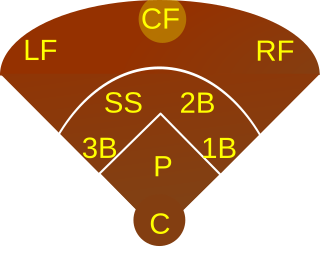 W
WA center fielder, abbreviated CF, is the outfielder in baseball who plays defense in center field – the baseball and softball fielding position between left field and right field. In the numbering system used to record defensive plays, the center fielder is assigned the number 8.
 W
WIn baseball, the designated hitter (DH) is a player that bats in place of the pitcher. The position is authorized by Major League Baseball Rule 5.11, and was adopted by the American League in 1973. Since then, almost all amateur, collegiate, and professional leagues have adopted the rule or some variant with the notable exception of MLB's National League and Nippon Professional Baseball's Central League.
 W
WA first baseman, abbreviated 1B, is the player on a baseball or softball team who fields the area nearest first base, the first of four bases a baserunner must touch in succession to score a run. The first baseman is responsible for the majority of plays made at that base. In the numbering system used to record defensive plays, the first baseman is assigned the number 3.
 W
WIn baseball, a lead or lead off is the short distance that a player stands away from their current base. This term should not be confused with "leadoff hitter", which is the first batter of a game or of an inning.
 W
WIn baseball, a leadoff hitter is a batter who bats first in the lineup. It can also refer to any batter who bats first in any inning.
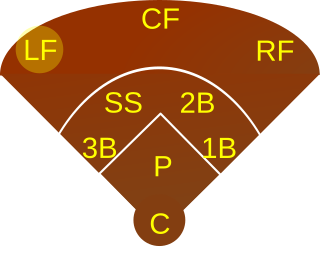 W
WIn baseball, a left fielder (LF) is an outfielder who plays defense in left field. Left field is the area of the outfield to the left of a person standing at home plate and facing towards the pitcher's mound. In the numbering system used to record defensive plays, the left fielder is assigned the number 7.
 W
WAn outfielder is a person playing in one of the three defensive positions in baseball or softball, farthest from the batter. These defenders are the left fielder, the center fielder, and the right fielder. As an outfielder, their duty is to catch fly balls and/ ground balls then to return them to the infield for the out or before the runner advances, if there is any runners on the bases. As an outfielder, they normally play behind the six players located in the field. By convention, each of the nine defensive positions in baseball is numbered. The outfield positions are 7, 8 and 9. These numbers are shorthand designations useful in baseball scorekeeping and are not necessarily the same as the squad numbers worn on player uniforms.
 W
WIn baseball, a pinch hitter is a substitute batter. Batters can be substituted at any time while the ball is dead ; the manager may use any player who has not yet entered the game as a substitute. Unlike basketball, American football or ice hockey, and in a similar way to association football, baseball does not have a "free substitution rule" and thus the replaced player in baseball is not allowed back into that game. The pinch hitter assumes the spot in the batting order of the player whom he replaces.
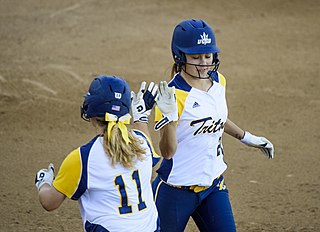 W
WA pinch runner is a baseball player substituted for the specific purpose of replacing a player on base. The pinch runner may be faster or otherwise more skilled at base-running than the player for whom the pinch runner has been substituted. Occasionally a pinch runner is inserted for other reasons, ejection, or if the original player on base has become injured.
 W
WIn baseball, the pitcher is the player who throws the baseball from the pitcher's mound toward the catcher to begin each play, with the goal of retiring a batter, who attempts to either make contact with the pitched ball or draw a walk. In the numbering system used to record defensive plays, the pitcher is assigned the number 1. The pitcher is often considered the most important player on the defensive side of the game, and as such is situated at the right end of the defensive spectrum. There are many different types of pitchers, such as the starting pitcher, relief pitcher, middle reliever, lefty specialist, setup man, and the closer.
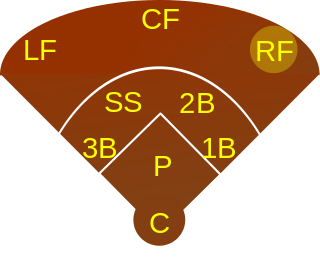 W
WA right fielder, abbreviated RF, is the outfielder in baseball or softball who plays defense in right field. Right field is the area of the outfield to the right of a person standing at home plate and facing towards the pitcher's mound. In the numbering system used to record defensive plays, the right fielder is assigned the number 9.
 W
WIn baseball and softball, second baseman, abbreviated 2B, is a fielding position in the infield, between second and first base. The second baseman often possesses quick hands and feet, needs the ability to get rid of the ball quickly, and must be able to make the pivot on a double play. In addition, second basemen are usually right-handed; only four left-handed throwing players have ever played second base in Major League Baseball since 1950. In the numbering system used to record defensive plays, the second baseman is assigned the number 4.
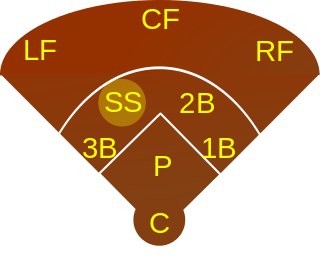 W
WShortstop, abbreviated SS, is the baseball or softball fielding position between second and third base, which is considered to be among the most demanding defensive positions. Historically the position was assigned to defensive specialists who were typically poor at batting and were often placed at the bottom of the batting order. Today shortstops are often able to hit well and many are placed at the top of the lineup. In the numbering system used by scorers to record defensive plays, the shortstop is assigned the number 6.
 W
WA third baseman, abbreviated 3B, is the player in baseball or softball whose responsibility is to defend the area nearest to third base — the third of four bases a baserunner must touch in succession to score a run. In the scoring system used to record defensive plays, the third baseman is assigned the number '5'.
 W
WIn baseball, a utility player is a player who typically does not have the offensive abilities to justify a regular starting role on the team but is capable of playing more than one defensive position. These players are able to give the various starters a rest, or replace a starter due to injury, or play late in a game to provide improved defense when their team is winning.